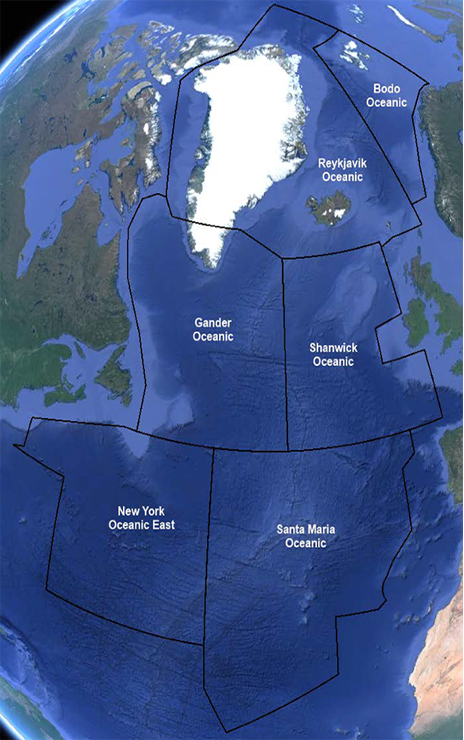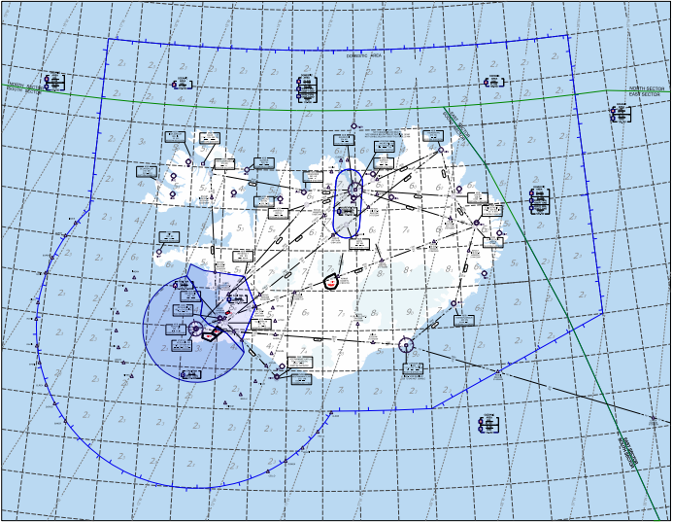Delivery
Clearance delivery in the Reykjavik CTA is a uniquely complex task, in no small part because the airspace structure of the Reykjavik CTA includes oceanic airspace.
When performing clearance delivery, DEL must always check the following elements of an aircraft's flight plan:
- SID & departure runway
- Flight plan route
- Initial climb (Cleared Flight Level / CFL)
- Cruising level (Requested Flight Level / RFL)
- Squawk code
As of 20th March 2024, Oceanic clearances are no longer required for departing aircraft.
SID & Departure Runway
DEL should verify that Euroscope has correctly assigned a valid SID (Standard Instrument Departure) for the flight. The SID should be valid for the active departure runway, connect to the aircraft’s flight plan route, and be appropriate for the aircraft’s performance category.
If Euroscope has assigned an invalid SID, then DEL should manually assign a valid SID on the Departure List.
Non-Standard Departures
Occasionally, an aircraft may be unable to accept an assigned SID. Reasons may include having an out-of-date AIRAC, lack of navigation equipment (e.g., non-RNAV), performance constraints (unable to meet minimum altitudes or climb gradients), etc.
In this case, DEL should coordinate with the overlying Approach (APP) unit. APP will issue non-standard departure instructions, such as:
- A radar vectored departure (fly heading XXX, or climb straight ahead to XXX ft.)
- Direct to the first flight plan waypoint.
- Visual climb (aircraft climb visually to their first flight plan waypoint; a left or a right turn may be specified on departure.)
Routing
Iceland & the Faroe Islands
BIRD FIR is Free Route Airspace (FRA), meaning that aircraft departing Iceland (as well as the Faroe Islands, which underlies BIRD FIR) are generally free to determine their own routings.
However, aircraft may still be subject to certain rules and restrictions to their routing. For example, departures from BIKF and BIRK are not permitted to use the G3 airway, except if they have short-range navigational equipment only. These restrictions are described in LOPs where relevant, and may be found in the Iceland AIP, ENR 1.8.3.1.3.7.
Greenland
BGGL FIR is not Free Route Airspace.
A "domestic" airways system has been established in BGGL FIR from FL285 and below. Details on the airways may be found in the Greenland AIP, ENR 3 (ATS Routes.) Generally, flights below FL285 are expected to fly via these airways.
Aircraft above FL285 are above Greenland's airway system. They are therefore subject to oceanic routing rules. See the "Oceanic Routing" section below, as well as Iceland AIP, ENR 1.8.3.1.3.7, for more information.
Initial Climb (CFL)
The standard initial climb from all Icelandic airports is FL290, or the aircraft's requested flight level (RFL) if lower.
Initial climb for departures from EKVG and Greenland (BG**) is at the discretion of Reykjavik Control. Traffic permitting, Reykjavik may clear the aircraft to climb directly to RFL.
DEL should verify that the initial climb is set correctly on Euroscope on the CFL (Cleared Flight Level) list item.
Cruising Flight Level (RFL)
DEL should verify that the aircraft’s Requested Flight Level (RFL), i.e. its cruising level, is valid.
In the Reykjavik CTA, IFR cruising levels are allocated following these rules:
- 2000ft – FL410: Levels are separated by 1000ft, and allocated following the East/West semi-circular rule.
- I.e., flights with an Eastbound track (000-179°) fly at odd thousands of feet, and flights with a Westbound track (180-359°) fly at even thousands of feet.
- Technically, between FL290-FL410, this is subject to RVSM approval. However, on VATSIM, we assume that any aircraft requesting to fly in RVSM airspace is RVSM approved.
- Above FL410: Levels are separated by 2000ft. E.g., FL410 Eastbound, FL430 Westbound, FL450 Eastbound, etc.
Oceanic Departures
Oceanic Airspace
Much of the airspace within the Reykjavik CTA is designated as oceanic airspace. The parts of the Reykjavik CTA which are designated as oceanic airspace are known as the Reykjavik Oceanic Area (OCA).
The Reykjavik OCA is one of six oceanic areas which make up the North Atlantic (NAT) oceanic airspace. The other five are Gander, Shanwick, New York, Santa Maria, and Bodo OFIR (Oceanic FIR).
Any departure from Iceland, Greenland, or the Faroe Islands which will enter oceanic airspace must obtain oceanic clearance on the ground. This is delivered by voice as part of a "combined" IFR and oceanic clearance.
The exact criteria for whether or not aircraft require an oceanic clearance are detailed below.
Departures from Iceland (BI**)
The Icelandic Domestic Area (GND — FL245) is depicted in the following image with a thick blue line.
If the aircraft leaves the Domestic Area, then it requires an oceanic clearance. If it does not, then it may be issued a normal (domestic) IFR clearance.
Controllers are reminded that aircraft may leave the Domestic Area either by climbing out or by leaving its lateral boundaries.E.g., if an aircraft seems to remain within the lateral boundaries of the Domestic Area, but has a requested level of >FL245, then it leaves the Domestic Area and requires an oceanic clearance.
Departures from EKVG
All departures climbing above 5500ft / FL55 require oceanic clearance. Vagar AFIS (EKVG_I_TWR) will coordinate such requests with Reykjavik Control.
(Flights below FL55 / 5500ft will not enter controlled airspace, and thus should not be issued any IFR or oceanic clearance.)clearance)
Departures from Greenland (BG**)
All departures climbing above FL285, and/or leaving BGGL FIR,if at FL285 or below require oceanica clearance.
Departures remaining only within BGGL FIR and remaining below FL285 do not require oceanic clearance, and may be issued a normal (domestic) IFR clearance.
Oceanic Routing
The oceanic routing of a flight refers to the portion of its route within the NAT oceanic airspace as a whole– not just Reykjavik OCA, but also Gander, Shanwick, etc.
If an aircraft will remain in oceanic airspace for its entire flight, their oceanic routing is equivalent to their entire flight plan route.
It is necessary to determine and check the oceanic routing for two reasons:
It is necessary to state the routing in the oceanic clearance.There are certain routing guidelines and restrictions applicable to oceanic routings.As a general rule, oceanic flights south of 70N (the majority of traffic) should have a routing consisting of coordinates, withone point for every 10 degrees of longitude(40W, 50W, etc.) The flight time between points should be no more than 1 hour.Further restrictions, e.g. for flights above 70N, are detailed in the Iceland AIP, ENR 1.8.3.1.3.7.
Mach Number
If a flight requires an oceanic clearance, DEL must obtain the flight's requested Mach number.
DEL should first check if the pilot has filed their requested Mach number at the start of their flight plan route. This follows the format MxxxFxxx – for example, “M078F350” means Mach 0.78 at a requested cruising level of FL350. If the Mach number is not in the aircraft’s flight plan, DEL should ask the pilot what their requested Mach number is.
Upon obtaining the aircraft’s requested Mach number, DEL should input the Mach number in:
The Departure List under the MACH column.The beginning of the aircraft’s flight plan route, following the MxxxFxxx convention, if the pilot did not do so themselves.
If the aircraft is too slow to fly a Mach number (as is the case for most light fixed-wing aircraft), then the Mach number may be omitted from their oceanic clearance, and it is not required to input anything into the MACH column of the Departure List.
SSR Code
After DEL has checked all of the above elements of the flight plan, DEL should assign the aircraft a discrete four-digit squawk code via TopSky.
Clearance Phraseology
Domestic IFR Clearance
[CALLSIGN], cleared to [DEST] via [SID], climb via SID [CFL], [SQUAWK].
For example:
🎧 ICE123, cleared to Akureyri, via the LUTER 2A departure, climb via SID
FL230,FL290, squawk 4110.
Combined Oceanic + IFR Clearance
[CALLSIGN], oceanic clearance to [DEST], via [SID], [OCEANIC ROUTING], climb via SID [CFL], [MACH]*, [SQUAWK].
*If an aircraft is flying too slow for a Mach number, then simply leave out the Mach number from the clearance.
For example:
🎧 ICE456, oceanic clearance to Copenhagen, via the OSKUM 3A departure, 63 North 10 West, IPTON, climb via SID FL290, Mach .79, squawk 3234.
Both full-degree coordinates like 63N010W, and half-degree coordinates like 6330N01000W, should be pronounced as "63 North 10 West."
Non-Standard Clearances
Reroutes
When an aircraft’s clearance contains changes to its route, DEL should add the phrase “with a reroute” to the clearance. DEL may alternatively give the new routing in a separate transmission, if the new routing is very long.
Non-Standard Departures (Not on a SID)
For aircraft which are not following a SID, then their departure instructions (as coordinated with APP) should be given following the phrase “after departure runway XX…” For example:
🎧 ICE236, cleared to Akureyri, after departure runway 01 climb straight ahead to 5000ft, squawk 1217.
Since the aircraft is not following a SID, the initial climb may be issued simply as “climb XXX.” If the aircraft is climbing straight to its cruising level, the word “climb” may also be omitted, as in the 2nd example below:
🎧 ICE237, cleared to Akureyri, after departure runway 19 direct REKVA, FL230, squawk 1227.
After Issuing Clearance
Upon the pilot's correct readback, they should be instructed to report ready for push & start on the delivery frequency. Only when the aircraft is ready should they be transferred to GND. This is to ensure they are on frequency, should DEL have to re-clear them.
If a VFR aircraft calls DEL, DEL should instruct them to contact GND. DEL does not issue VFR clearances.


